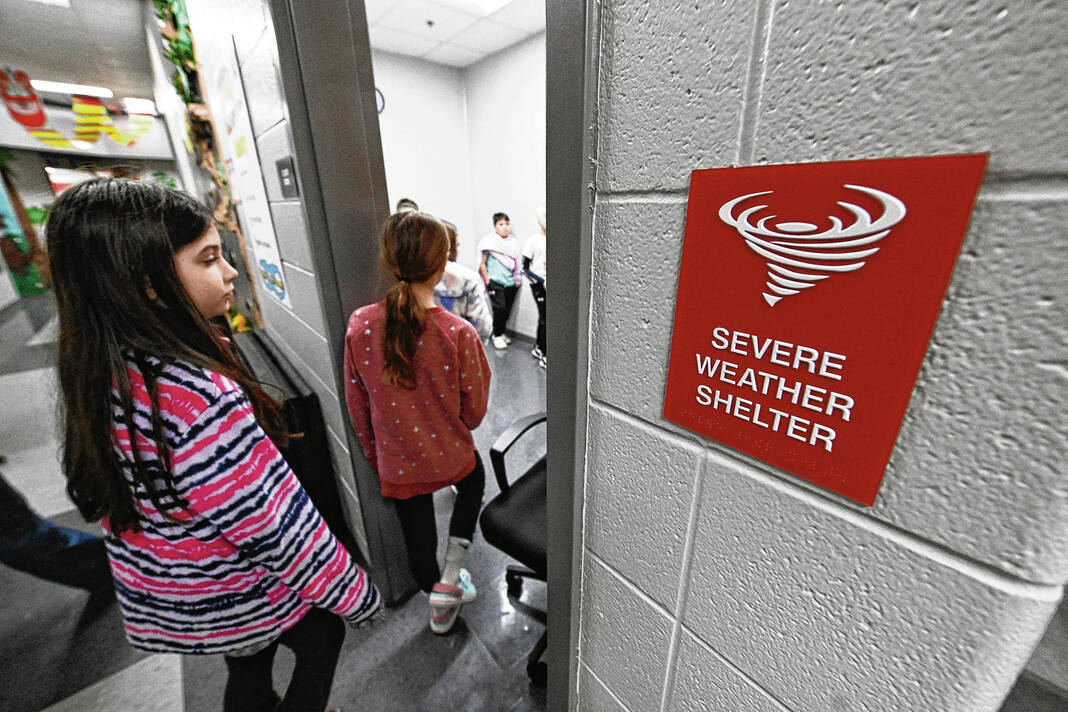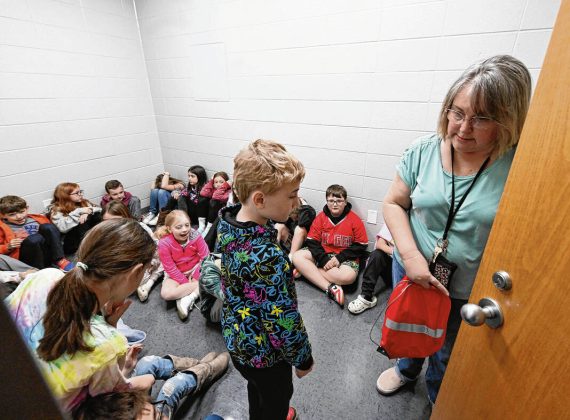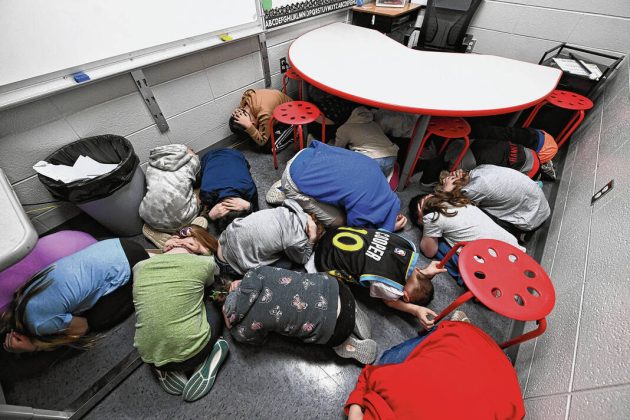HANCOCK COUNTY — When assistant principal Nik Giant spoke over the intercom system, he told the students at New Palestine Elementary School (NPES) it was time to practice a severe weather drill. The students quietly got into lines and walked out of their classrooms and into the center of the building, then filed into inner-building rooms.
“It is severe weather season,” Giant said. “We practiced one of these drills in the fall, and we do one each spring and have the teachers talk with their kids so, that way, if we ever need to really do this, kids won’t be so scared.”
Once inside the inner rooms without windows and inside places like the inner restrooms, the children tucked into balls and covered their heads until an all-clear was given.
“We actually time these types of drills so we can see how quickly these drills can be done because we want to be efficient,” New Palestine Community Schools, Community Relations Director, Craig Smith said. “Afterwards, we’ll look and see if there are any questions that come out of this that we can answer to make sure we are doing these types of safety drills as best we can.”
The first day of spring is Tuesday. That means it’s officially the season to be prepared for just about any kind of weather in Indiana, including everything from a snow storm to dangerous spring thunderstorms which occurred Thursday night across the state and included a tornado warning for Hancock County.
Governor Eric Holcomb proclaimed March 10–16 as Severe Weather Preparedness Week to remind and educate Hoosiers about seasonal severe weather threats and how to effectively prepare for them.
The Indiana Department of Homeland Security held the Statewide Tornado Drill earlier this week with most businesses and schools taking part Tuesday or later in the week, like officials at NPES, who conducted their severe weather drill Thursday morning.
These types of drill occurs each year in order to remind people to have a tornado safety plan.
“We experience severe weather frequently, but we cannot overlook how we prepare for these storms,” IDHS Emergency Management and Preparedness Director Mary Moran said in a release. “Check in with your family members. Make sure they know what to do and when to do it if a storm approaches.”
Officials with Hancock Homeland Security (formerly known as Hancock County Emergency Management) also participated in the statewide tornado drill Tuesday. Officials there said they plan to share more information with area residents about county siren safety in early April via a video on their social media sites. However, they too note Indiana spring weather is particularly unpredictable, so it’s best for people to be prepared now.
Forty-six severe weather sirens are located throughout Hancock County to warn area citizens of impending severe weather, and they are tested remotely each spring.
“The entire outdoor siren system was completely overhauled about five years ago and is currently up-to-date,” Public Information Officer for Hancock Homeland Security Greg Duda said. “We are currently working on placing two new sirens in the eastern part of the county to give us even more coverage.”
Hancock County Homeland Security monitors and activates the sirens in the event of a tornado warning within the county or a spotted funnel cloud reported by a trained weather spotter or public safety official.
“The sirens are activated by us, as they are not automatic,” Duda said. “Text alerts and weather radio broadcasts regarding severe weather and warnings are automatic via the National Weather Service in Indianapolis.”
Duda noted that they always want people to take tornado sirens seriously and get to shelter immediately due to the fact county officials only sound the sirens in the event of an imminent and actual threat.
However, officials note outdoor warning sirens should not be relied upon as the primary means of sever weather notification.
According to county officials, tornadoes are nature’s most violent storms and can leave an area devastated in minutes. They can strike at any time of the day and during any season of the year. In Indiana, tornadoes occur most frequently in March, April, May and June.
Despite warnings from sirens, officials say weather radios are the preferred method for warning area residents foul weather is approaching. Sirens are meant to be heard outside and cannot be relied on for those who are indoors, officials say.
That’s why officials note it is best to have a NOAA weather radio or weather alert app on your cell phone.
One of the fastest, most accurate and reliable means of receiving severe weather information is through a NOAA Weather Radio with a “tone alert” feature and battery backup. Weather radios may be purchased at local electronics stores.
NOAA Weather Radio is operated directly from the National Weather Service office in Indianapolis, which provides coverage for Hancock County. The weather radio “tone alert” is activated when weather watches and warnings are issued.
Newer models are capable of warning residents only if severe weather is expected to reach Hancock County. This feature is called Specific Area Message Encoding (SAME). Ask your local electronics retailer for help programming your weather radio before you leave the store.
Officials warn county residents should have a family disaster plan and can actually visit www.hancockin.gov/231/Family-Disaster-Plan and find out more information on how to get a plan together, including creating a family disaster safety kit.
Also, everyone in Hancock County can sign up for free alerts through Smart 911. They can either go to www.smart911.com or www.hancockin.gov and under the “How do I?” banner, select sign up for alerts.
Quick Severe Weather Safety Tips:
- When you hear thunder, you are within striking distance of lightning. Go indoors when you hear thunder.
- Consider how you would be alerted if there were a tornado warning. Sirens are meant to be heard outside and cannot be relied on if you are indoors. Have a NOAA weather radio or weather alert app.
- Have a location designated as your safe spot regardless of what kind of building you are in. A basement or storm shelter is best, but an interior room, stairway or hall without a window or door to the outside is acceptable.
- Find out what flood insurance coverage would cost to add to your policy for your home. New policies take 30 days to become effective, so you need to add coverage well before any anticipated flooding.
- Know how to be alerted to possible severe weather, make a plan of where to take shelter or evacuate, and keep an emergency disaster kit ready at all times.
Source: in.gov







